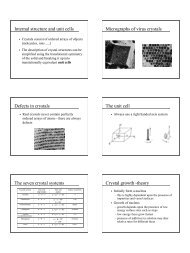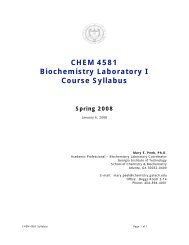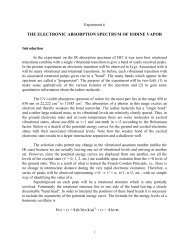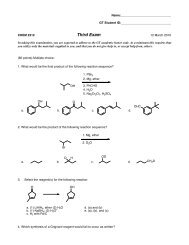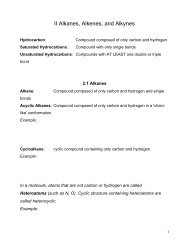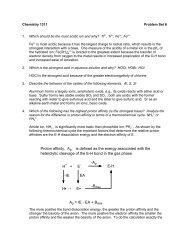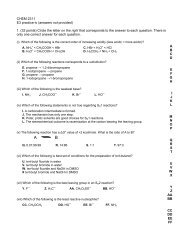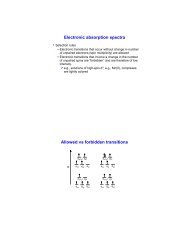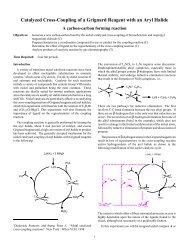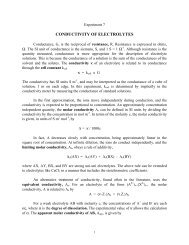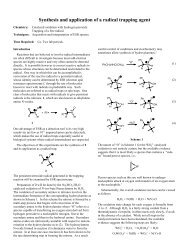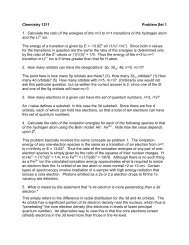Topic 5 Acid and Bases Acid and Bases
Topic 5 Acid and Bases Acid and Bases
Topic 5 Acid and Bases Acid and Bases
You also want an ePaper? Increase the reach of your titles
YUMPU automatically turns print PDFs into web optimized ePapers that Google loves.
<strong>Topic</strong> 5<br />
5-1<br />
<strong>Acid</strong> <strong>and</strong> <strong>Bases</strong><br />
<strong>Acid</strong> <strong>and</strong> <strong>Bases</strong><br />
5-2<br />
There are a number definitions for aicd <strong>and</strong> bases, depending on<br />
what is convenient to use in a particular situation:<br />
• Arrhenius <strong>and</strong> Ostwald: Theory of electrolyte dissociation<br />
acid + base<br />
salt + water<br />
• Brønsted <strong>and</strong> Lowry (1923): Protontransfer reactions<br />
– <strong>Acid</strong> is proton donor, base is proton acceptor<br />
• Lewis (1923): Generalization of previous theories<br />
– <strong>Acid</strong> is electron pair acceptor, base is electron pair donor<br />
–> Neutralization: formation of a covalent bond between acid <strong>and</strong> base
Brønsted-Lowry <strong>Acid</strong> <strong>and</strong> <strong>Bases</strong><br />
5-3<br />
A Brønsted-Lowry acid is a substance that can donate a hydrogen ion<br />
A Brønsted-Lowry base is a substance that can accept a hydrogen ion<br />
HCl + NH 3 NH 4<br />
+<br />
+ Cl –<br />
acid base conjugate acid conjugate base<br />
Note: Water can act as base or an acid = amphoteric behavior:<br />
–> H 2 O is the conjugate acid of OH – <strong>and</strong> the conjugate base of H 3 O +<br />
–> H 3 O + is the conjugate acid, OH – the conjugate base of H 2 O<br />
Brønsted-Lowry <strong>Acid</strong> <strong>and</strong> <strong>Bases</strong><br />
5-4<br />
• The Brønsted-Lowry definition includes also acid-base reactions in<br />
the gas phase, or in solvents other than water, e.g. liquid ammonia:<br />
2 NH 3 NH 4<br />
+<br />
+ NH 2<br />
–<br />
2 H 2 O H 3 O + + OH –<br />
Note: In any solvent, the direction of the reaction is always such, that the<br />
products are weaker acids or bases than the reactants
Solvent Dissociation Theory<br />
5-5<br />
• The Brønsted-Lowry theory is limited to proton transfer reactions<br />
(<strong>and</strong> mostly aqueous systems), therefore, aprotic nonaqueous<br />
systems require a different definition of acid <strong>and</strong> base:<br />
The cation resulting from autodissociation of a solvent is the acid<br />
The anion resulting from autodissociation of a solvent is the base<br />
2 H 2 O H 3 O + + OH –<br />
acid base<br />
Other solvent dissociation equilibria:<br />
Properties of Solvents<br />
5-6
Dissociation of Pure Water<br />
5-7<br />
The autodissociation of water proceeds only to a slight extent, but is<br />
responsible for a small but measurable presence of H 3 O + <strong>and</strong> OH –<br />
ions:<br />
K<br />
2 H 2 O H 3 O + + OH –<br />
Pure water contains no other ions than H 3 O + <strong>and</strong> OH – <strong>and</strong> the<br />
negative charges must be equal the positive:<br />
[H 3<br />
O + ] = [HO ! ] = 10 !7 M neutral solution<br />
[H 3<br />
O + ] > [HO ! ]<br />
[H 3<br />
O + ] < [HO ! ]<br />
acidic solution<br />
basic solution<br />
The pH Function<br />
5-8<br />
In aqueous solution the concentration of hydronium ions can range<br />
from 10 M to 10 –15 M. It is convenient to express this large range by a<br />
logarithmic scale, the pH scale:<br />
Neutral pH: [H 3 O + ] = 10 –7 M –> pH = 7<br />
<strong>Acid</strong>ic range [H 3 O + ] > 10 –7 M –> pH < 7<br />
Basic range [H 3 O + ] < 10 –7 M –> pH > 7
The Strength of <strong>Acid</strong>s <strong>and</strong> <strong>Bases</strong><br />
5-9<br />
<strong>Acid</strong>s are classified as strong or weak depending on whether their<br />
reaction with water to give H 3 O + (aq) go to completion or reach an<br />
equilibrium:<br />
HA + H 2 O H 3 O + + A –<br />
The acidity constant K a (also called acid dissociation constant or<br />
acid ionization constant) is a quantitative measure of the strength of<br />
the acid in a given solvent (in this case water)<br />
–> the larger K a the stronger the acid<br />
Note: <strong>Acid</strong>ity constants are typically written as pK a values:<br />
5-10<br />
<strong>Acid</strong>ity Constants in Water
Base Strength<br />
5-11<br />
The strength of a base is inversely related to the strength of its<br />
conjugated acid: the weaker the acid, the stronger the conjugated<br />
base <strong>and</strong> vice versa.<br />
K b<br />
B + H 2 O HB + + OH –<br />
K b is the basicity constant. Since K w<br />
= [H 3<br />
O + ][HO ! ] = 10 –14 M 2<br />
we can also write:<br />
Multiple Equilibria<br />
5-12<br />
If two bases compete for hydrogen ions, the stronger base “wins” <strong>and</strong><br />
will hold the larger portion of hydrogen ions:<br />
K<br />
HF + CN – HCN + F –<br />
K = [HCN][F ! ]<br />
[HF][CN – ]<br />
We can calculate K from the tabulated values for the two individual<br />
chemical equilibria involved:<br />
K a<br />
HF + H 2 O H 3 O + + F – K a<br />
= [H 3 O+ ][F ! ]<br />
= 6.6"10 !4<br />
[HF]<br />
K’ a<br />
HCN + H 2 O H 3 O + + CN – K a<br />
= [H 3 O+ ][CN ! ]<br />
= 6.2 "10 !10<br />
[HCN]
5-13<br />
<strong>Acid</strong> vs. Conjugate Base Strengths<br />
Indicators<br />
5-14<br />
An indicator is a soluble compound, generally an organic dye, that<br />
changes its color noticeably over a fairly short range of pH:<br />
K a<br />
HInd + H 2 O H 3 O + + Ind – K a<br />
= [H 3O + ][Ind ! ]<br />
[HInd]<br />
<strong>and</strong><br />
[H 3<br />
O + ]<br />
K a<br />
= [HInd]<br />
[Ind ! ]<br />
If [H 3 O + ] is much larger than K a , then [HInd] > [Ind – ]<br />
–> most of the indicator is protonated, <strong>and</strong> the color of the acid form<br />
is predominant (<strong>and</strong> vice versa)
5-15<br />
Indicator Color Change as Function of pH<br />
Color Change of Phenolphtalein<br />
5-16<br />
OH<br />
O<br />
O<br />
O<br />
K a<br />
H 3 O +<br />
O<br />
O<br />
OH<br />
O<br />
colorless<br />
acidic solution<br />
red<br />
basic solution<br />
The red color of the deprotonated indicator (pH > 8) is due to the<br />
extended <strong>and</strong> delocalized pi-system (resonance structures)<br />
–> the HOMO-LUMO energy difference is smaller in the conjugated<br />
pi-system, which shifts the absorption wavelength into the visible<br />
range
pH Indicators in Biology<br />
5-17<br />
SNARF is a pH sensitive fluorescent probe, which can be used to<br />
measure the pH value inside a living cell using fluorescence microscopy:<br />
O<br />
OH<br />
Me 2 N<br />
O<br />
Me 2 N<br />
O<br />
K a<br />
COO<br />
COO<br />
H 3 O + 5-18<br />
Human neutrophils loaded<br />
with SNARF<br />
pH Range in Various Solvents
Equilibria of Weak <strong>Acid</strong> <strong>and</strong> <strong>Bases</strong><br />
5-19<br />
• Weak acid <strong>and</strong> bases react only partially with water to form H 3 O + or<br />
OH –<br />
–> pH calculations must be performed based on K a or K b <strong>and</strong> the<br />
involved thermodynamic equilibrium<br />
K a<br />
HA + H 2 O H 3 O + + A –<br />
K a<br />
= [H 3O + ][A ! ]<br />
[HA]<br />
Solve equation for [H 3 O + ]<br />
–> calculate pH<br />
pH Calculations<br />
5-20<br />
Example: pH of 1.0 M acetic acid (K a = 1.8E-5):<br />
K a<br />
CH 3 COOH + H 2 O H 3 O + + CH 3 COO –<br />
Since acetic acid is a weak acid, we can approximate above quadratic equation with<br />
1.00–y ≈ 1.00, thus<br />
And the fraction of ionized acetic acid is calculated to be:
pH Calculations: Diluted Solutions<br />
5-21<br />
If water is added to further dilute acetic acid, the concentration of H 3 O +<br />
decreases (moving towards 10 –7 M), <strong>and</strong> the fraction of the ionized acid<br />
CH 3 COO – increases.<br />
Example: pH of 0.0001 M acetic acid:<br />
K a<br />
= [H 3O + ][CH 3<br />
COO " ]<br />
[CH 3<br />
COOH]<br />
Solving above equation with the same approximation as before gives a 42%<br />
fraction of ionized acid –> the approximation is not valid anymore, <strong>and</strong> the<br />
quadratic ! equation must be solved accurately:<br />
[H 3<br />
O + ] = [CH 3<br />
COO " ]<br />
ionized fraction: 5-22<br />
!<br />
f = [CH 3 COO– ]<br />
[CH 3<br />
COOH] "100<br />
!<br />
Weak <strong>Bases</strong><br />
Example: pH of 0.01 M ammonia (K b = 1.8E-5):<br />
K a<br />
NH 3 + H 2 O NH<br />
+<br />
4 + OH –<br />
K b<br />
= [NH + 4<br />
][OH " ]<br />
[NH 3<br />
]<br />
Above quadratic equation is solved again for y:<br />
!<br />
[NH 4 + ] = [OH " ]<br />
The hydronium ion concentration (<strong>and</strong> pH) of the solution is then obtained via K w :<br />
!<br />
[H 3<br />
O + ] = K w<br />
[OH " ]<br />
!
Hydrolysis Reactions<br />
5-23<br />
• Some anionic or cationic species react with water to give an acidic<br />
or basic solution<br />
• For example, the ammonium cation NH 4<br />
+<br />
is hydrolyzed to give an<br />
acidic solution:<br />
K a<br />
!<br />
NH 4<br />
+<br />
+ H 2 O H 3 O + + NH 3<br />
K a<br />
= [H 3O + ][NH 3<br />
]<br />
[NH 4 + ]<br />
• Similarly, hydrolysis of F – ion increases the OH – concentration <strong>and</strong><br />
so raises the pH:<br />
F – + H 2 O<br />
K a<br />
OH – + HF<br />
5-24<br />
Hydrolysis<br />
• Most ionic species hydrolyze to a detectable extent:<br />
–> the hydrolysis of anions typically raises the pH<br />
–> the hydrolysis of cations typically lowers the pH<br />
• Metal cations with a large charge/size ratio undergo extensive<br />
hydrolysis reactions:<br />
Al(H 2 O) 6<br />
3+<br />
+ H 2 O<br />
• +1 metal cations <strong>and</strong> large +2 cations do not undergo hydrolysis<br />
(pK a > 7) (Li + , Na + , K + , Rb + , Cs + , Mg 2+ , Ca 2+ , Sr 2+ , Ba 2+ )<br />
• The conjugate bases of very strong acids are nonhydrolyzing<br />
anions: ClO 4– , Cl – , Br – , I – , HSO 4– , NO 3<br />
–
5-25<br />
Hydrolysis Constants of Cations<br />
Buffer Solutions<br />
5-26<br />
Buffer solution = any solution that maintains an approximately constant pH<br />
despite small additions of acid or base<br />
–> typically a buffer solution contains a weak acid <strong>and</strong> a weak base that are<br />
conjugate to one another<br />
Example: Calculate the pH of a mixture of 1M HCOOH <strong>and</strong> 0.5 M NaHCOO<br />
K a (formic acid) = 1.8E–4:<br />
K a<br />
HCOOH + H 2 O H 3 O + + HCOO –<br />
Since acetic acid is a weak acid, we can approximate above quadratic equation with<br />
1.00–y ≈ 1.00 (<strong>and</strong> 0.5+y ≈ 0.5):
How Buffer Solutions Work<br />
5-27<br />
• In a buffer solution the concentration of [HA] <strong>and</strong> [A – ] are similar,<br />
<strong>and</strong> therefore the addition of small amounts of acid or base will not<br />
affect the [H 3 O + ] concentration substantially:<br />
Designing Buffers<br />
5-28<br />
• Assuming that the equilibrium concentrations of [HA] <strong>and</strong> [A – ] are<br />
very close to the initial total concentrations ([HA] 0 <strong>and</strong> [A – ] 0 ), we can<br />
write:<br />
K a<br />
= [H 3 O+ ][A ! ]<br />
[HA]<br />
" [H 3 O+ ][A ! ] 0<br />
[HA] 0<br />
• Solving for [H 3 O + ] <strong>and</strong> using the definitions for pK <strong>and</strong> pH gives:<br />
Henderson-Hasselbalch<br />
Equation
Concentration Dependence<br />
5-29<br />
• Continuos dilution of buffer solutions will gradually change the<br />
pH towards 7, since the initial assumption of [HA] 0 ≈ [HA] <strong>and</strong><br />
[A – ] 0 ≈ [A – ] does not apply at low buffer concentrations<br />
pH vs. conc. plots for various buffer<br />
systems:<br />
1: Sodium phosphate<br />
2: Ammonia<br />
3: 2,4-dichlorophenol<br />
4: Uric <strong>Acid</strong><br />
5: Acetic acid<br />
6: H 2 B 4 O 7<br />
7: Phosphoric acid<br />
<strong>Acid</strong>-Base Titration Curves<br />
5-30<br />
• A graph of pH versus the volume of titrating solution is called<br />
titration curve:<br />
–> the exact shape of an acid-base<br />
titration curve can be calculated based on<br />
the ionization constants of the acid <strong>and</strong><br />
base <strong>and</strong> their concentrations<br />
–> the titration curve can be used to<br />
calculate an unknown ionization constant<br />
of an acid or base (by titration with a<br />
known base or acid)
Titration of a Strong <strong>Acid</strong> with a Strong Base<br />
5-31<br />
• Simplest type of titration, the chemical reaction corresponds to a<br />
neutralization reaction:<br />
The pH at each point of the titration<br />
curve can be calculated (or<br />
measured) assuming complete<br />
reaction of the added base <strong>and</strong><br />
acid present<br />
Concentration Dependence<br />
5-32<br />
• Since the measured pH reflects the total [H 3 O + ] concentration,<br />
the shape of the titration curve depends on the concentration of<br />
the acid (<strong>and</strong> added base):
5-33<br />
Titration of a Weak <strong>Acid</strong> with a Strong Base<br />
Example: Titration of acetic acid with NaOH: The titration curve has four<br />
distinct ranges:<br />
1) Before NaOH addition:<br />
pH given by ionization of a weak acid<br />
2) Less than 1 molar equivalent of NaOH added:<br />
OH– is a much stronger base than acetate,, <strong>and</strong> therefore substracts the proton<br />
from acetic acid to form NaOAc<br />
–> the pH can be calculated using the Henderson-Hasselbalch equation<br />
(buffered region of the titration curve)<br />
Note: At the half equivalence point (V=V e /2) pH ≈ pK a = 4.74<br />
3) Equivalence point (V NaOH = V HOAc ):<br />
All the protons of acetic acid are neutralized –> the pH is identical with the pH<br />
of a solution of NaOAc of identical concentration<br />
4) After addition of more than 1 molar equivalent of NaOH:<br />
Beyond the equivalence point, all the acetic acid has been neutralized. The<br />
pH of the solution is approximately identical with the pH observed in the<br />
titration of a strong acid <strong>and</strong> strong base.<br />
Titration of HOAc with NaOH<br />
5-34
Polyprotic <strong>Acid</strong>s<br />
5-35<br />
• Polyprotic acids donate two or more hydrogen ions in stages<br />
(e.g. H 2 CO 3 , oxalic acid, phosphoric acid)<br />
Note: Even though acetic acid (CH 3 COOH) has a total of four hydrogen atoms, it<br />
is a monoprotic acid (only one of the four hydrogen atoms is acidic!)<br />
• The titration of a diprotic weak acid involves two simultaneous<br />
equilibria:<br />
K a1<br />
!<br />
H 2 CO 3 + H 2 O H 3 O + + HCO 3<br />
–<br />
K a1<br />
=<br />
K a2<br />
HCO<br />
–<br />
3 + H 2 O H 3 O + + CO<br />
2–<br />
3<br />
!<br />
K a2<br />
=<br />
Titration of Polyprotic <strong>Acid</strong>s<br />
5-36<br />
• As shown for monoprotic acids, the titration points can be<br />
calculated according to the involved equilibria with the<br />
corresponding ionization constants<br />
If the pK a values reasonably apart<br />
from each other, the inflection points<br />
of the titration curve directly reflect the<br />
equilibrium positions where pH ≈ pK a
Effect of pH on Solution Composition<br />
5-37<br />
• Changing the pH shifts the positions of all acid-base equilibria in<br />
a solution, <strong>and</strong> therefore the overall composition with respect to<br />
the involved species<br />
H 2 CO 3 + H 2 O H 3 O + + HCO 3<br />
–<br />
HCO 3<br />
–<br />
+ H 2 O H 3 O + + CO 3<br />
2–<br />
Solution composition for the<br />
carbonate equilibrium as a<br />
function of pH<br />
The pH of Blood<br />
5-38<br />
• Human blood has a pH near 7.4 that is maintained by a<br />
combination of carbonate, phosphate <strong>and</strong> protein buffers (a blood<br />
pH below 7.0 or above 7.8 leads quickly to death)<br />
The blood pH is depended on pCO 2 , the<br />
partial pressure of CO 2<br />
–> in order to get the non-respiratory pH,<br />
the pH is measured at two different CO 2<br />
partial pressures, the intersection at 40<br />
mmHg CO 2 gives then the (st<strong>and</strong>ardized)<br />
non-respiratory blood pH<br />
Deviations from pH 7.4 are indicative of<br />
various disease conditions<br />
(respiratory or metabolic acidosis or<br />
alkalosis)<br />
Actual pH<br />
Non-respiratory pH
Potentiometry<br />
5-39<br />
• The accurate measurement of [H 3 O + ] concentration with a pH<br />
electrode allows to solve complicated equilibrium systems with<br />
many species, including metal complexes:<br />
Lewis <strong>Acid</strong> <strong>and</strong> <strong>Bases</strong><br />
5-40<br />
A Lewis base is any species that donates electrons through coordination<br />
to its lone pairs, a Lewis acid is any species that accept such electron<br />
pairs.<br />
–> In addition to the reactions previously discussed, the Lewis definition is<br />
much broader <strong>and</strong> includes reactions such as:<br />
Ag + + 2 NH 3 [H 3 N-Ag-NH 3 ] +<br />
acid base adduct<br />
BF 3 + NH 3 H 3 N-BF 3
Donor Acceptor Bonding<br />
5-41<br />
empty p orbital<br />
(LUMO)<br />
filled orbital<br />
(lone pair, HOMO)<br />
energy<br />
Types of Lewis <strong>Acid</strong>s<br />
5-42<br />
• Metal cations can act as Lewis acids<br />
Ag + , Ga + , Fe 3+ etc.<br />
• Molecules with incomplete octets can act as Lewis acids<br />
BMe 3 , BF 3 , “AlH 3 ”<br />
• Molecules with complete octets can change their bonding to<br />
accommodate the base, for example CO 2<br />
CO 2 + OH - HCO 3<br />
-<br />
• A molecular species may become hypervalent to accommodate<br />
the base, for example PF 5<br />
PF 5 + F - PF 6<br />
-<br />
• Both low lying s <strong>and</strong> p anti-bonding orbitals can be used<br />
I 2 + I - I 3<br />
-
I 2 as a Lewis acid<br />
5-43<br />
• Lewis bases such as I - can interact with the sigma antibonding<br />
orbital in I 2 <strong>and</strong> form an adduct<br />
UV-vis absorption spectrum:<br />
Bromine as a Lewis acid<br />
5-44
Strengths of Lewis acids <strong>and</strong> bases<br />
5-45<br />
Not as simple to rationalize as Bronsted acids <strong>and</strong> bases<br />
• relative acid strength depends upon which base you are<br />
considering<br />
• <strong>and</strong> relative base strength depends upon which acid you are<br />
considering!<br />
Example:<br />
In aqueous solution Ag + has a stronger affinity for NH 3 than for F -<br />
– this implies that NH 3 is a better base<br />
In aqueous solution Ca 2+ has a stronger affinity for F - than for NH 3<br />
– this implies that F - is a better base<br />
Soft <strong>and</strong> hard acids/bases<br />
5-46<br />
• In any interaction between an acid <strong>and</strong> a<br />
base to form an adduct the bonding can be<br />
anywhere between ionic <strong>and</strong> covalent<br />
• The hard/soft acid base principle relates to<br />
the degree of covalency in the bonding<br />
a hard acid is an acid that would rather bind<br />
to F - than I -<br />
• Hard bases have a high affinity for hard<br />
acids <strong>and</strong> soft bases have a high affinity for<br />
soft acids
<strong>Acid</strong>ity <strong>and</strong> Basicity of Binary Hydrides<br />
5-47<br />
• Binary hydrogen compounds range from strong acids (HCl) to<br />
weak bases (NH 3 ), or non-acidic molecules (CH 4 )<br />
• <strong>Acid</strong>ity is greatest with lowest electronegativity in each group<br />
–> larger molecules have lower charge density <strong>and</strong> form less stable<br />
bonds to hydrogen<br />
–> larger molecules form more stable conjugate bases (better<br />
stabilization of negative charge)<br />
Example hard <strong>and</strong> soft acids/bases<br />
5-48<br />
Class<br />
<strong>Acid</strong>s<br />
<strong>Bases</strong><br />
Hard<br />
Borderline<br />
Soft<br />
H + , Li + , Na + , K + ,<br />
Mg 2+ , Ca 2+<br />
Fe 2+ , Co 2+ ,<br />
Ni 2+ , Cu 2+ ,<br />
Zn 2+ , Pb 2+<br />
Cu + , Ag + ,<br />
Hg 2<br />
2+<br />
, Hg 2+ ,<br />
Cd 2+<br />
H 2 O, NH 3 , F - ,<br />
Cl - , OH - , NO 3- ,<br />
ClO 4- , CO 3<br />
2-<br />
, O 2-<br />
, SO 4<br />
2-<br />
, PO 4<br />
3-<br />
NO 2- , Br - , SO 3<br />
2-<br />
CO, CN - , I - , S 2-
<strong>Acid</strong>ity <strong>and</strong> Basicity of Binary Hydrides<br />
5-49<br />
• Binary hydrogen compounds range from strong acids (HCl) to<br />
weak bases (NH 3 ), or non-acidic molecules (CH 4 )<br />
• <strong>Acid</strong>ity is greatest with lowest electronegativity in each group<br />
–> larger molecules have lower charge density <strong>and</strong> form less stable<br />
bonds to hydrogen<br />
–> larger molecules form more stable conjugate bases (better<br />
stabilization of negative charge)<br />
Inductive Effects<br />
5-50<br />
• Substitution of electronegative groups such as fluorine or<br />
chlorine in place of hydrogen results in weaker bases<br />
–> the central atom lone pair is less readily donated to an acid<br />
(e.g. PF 3 is a much weaker base than PH 3 )<br />
• Substitution with alkyl groups results stronger bases<br />
–> the central atom lone pair is more electron rich<br />
Example:<br />
Gas phase basicity is decreasing in the order:<br />
NMe 3 > NHMe 2 > NH 2 Me > NH 3
The Strength of Oxyacids<br />
5-51<br />
• In the series of oxyacids of chlorine, the acid strength in aqueous<br />
solution is decreasing in the order<br />
HClO 4 > HClO 3 > HClO 2 > HOCl<br />
pK a : –10 –1 2 7.2<br />
With increasing number of electronegative substituents on Cl, the O–H<br />
bond is weakened due to the increasing positive charge on Cl. At the same<br />
time the negative charge of the conjugate base is further stabilized.<br />
–> Both effects result in an increasing acidity<br />
• For oxyacids with more than one ionizable hydrogen, the pK a<br />
values increase by about 5 units with each successive removal:<br />
H 3 PO 4 > H 2 PO 4<br />
– > HPO 4<br />
2–<br />
pK a : 2.15 7.20 12.37<br />
Super <strong>Acid</strong>s<br />
5-52<br />
• Any acid solution which is more acidic than sulfuric acid is called<br />
a super acid<br />
–> super acid systems are necessarily nonaqueous, since the acidity of<br />
any aqueous system is limited by the fact that the strongest acid that<br />
can exist in the presence of water is H 3 O +<br />
• The acidity is measured by the Hammett acidity function (B/BH+<br />
is an indicator <strong>and</strong> its conjugate base):<br />
H 0<br />
! pK BH<br />
+ " log [BH+ ]<br />
[B]




